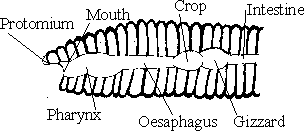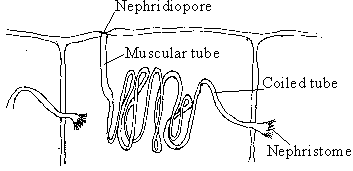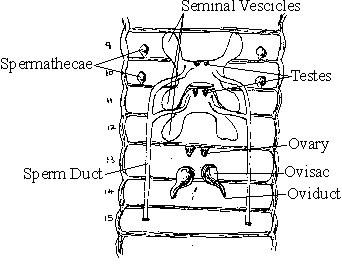Education Links
Leaving Cert
 Maths
Maths
 French
French
 English
English
 Chemistry
Chemistry
 Physics
Physics
 Biology
Biology
 Economics
Economics
 Spanish
Spanish
 Geography
Geography
 History
History
Junior Cert
The Earthworm (Lumbricus terrestris)
Phylum: Annelida (segmented worms)Characteristics:
External structure


Diet
Earthworms feed on detritus (i.e. small pieces of dead and decomposing plants and animals). They mainly feed on dead and decaying leaves.
The alimentary canal

Prostomium: Tastes and grips the food.
Pharynx: Pulls the food into the alimentary canal.
Oesophagus: Passes the food into the crop.
Crop: Stores and softens the food.
Gizzard: Mechanical digestion of food using pebbles and pieces of grit.
Intestine: Enzymes are released to chemically breakdown the food and the soluble pieces areabsorbed. There is an infolding on the dorsal side of the wall of the intestine which increases the surface area for absorption of food. This is called the typhlosole.
Anus: The undigested food and soil is egested through the anus as 'worm casts'.
Vascular system
As the earthworm is triploblastic coelomate transfer of materials by diffusion would not be adequate. Therefore, a specialised transport system is essential.
The earthworm has a closed system of blood vessels and a single circulation.
The major blood vessels are:
1. Ventral blood vessel: Below the alimentary canal, distributes the blood to various parts of the body and carries it towards the posterior end.
2. Branches of the ventral blood vessel: Take the blood to all the structures within each segment. These branches form capillaries, which return blood to the dorsal blood vessel.
3. Dorsal blood vessel: Above the alimentary canal, collects the blood from the body and carries it towards the anterior end.
4. Sub neural blood vessel: Below the nerve cord, drains the blood from the nerve cord and carries it towards the posterior end. In segments 7 - 11 there are five pairs of side vessels connecting the dorsal and the ventral blood vessels. These can contract and relax and are called pseudohearts (false hearts). They contract to pump the blood. Each heart has four valves which allows the blood to flow in a downward direction only and prevent an upwards flow.
The Nervous system
Earthworms do not have visible sense organs. Receptors sensitive to light, touch and chemicals are present along the body.
The cerebral ganglia or 'brain' lies above the pharynx. This is connected by a nerve collar to the ventral ganglion which lies below the pharynx. A nerve cord extends back along the body from the ventral ganglion. In each segment the nerve cord swells slightly to form a segmental ganglion from which three pairs of nerves branch off to supply all parts of the segment.
Movement
It involves the circular muscles, longitudinal muscles and setae. Each segment except for the first and the last has four pairs of setae. The setae help movement by gripping the soil.The circular muscles contract which makes part or all of the body becomes longer and thinner.
The longitudinal muscles contract which makes part or all of the body becomes shorter. The alternate lengthening and shortening of the body along with the correct positioning of the setae is what brings about movement.
Excretion

Reproduction
Earthworms are hermaphrodite. The reproductive parts are located in segments 9 to 15, and the clitellum is from segment 32 to 37.
Male reproductive organs

Cocoon formation
The importance of earthworms in agriculture
1. Their burrows increase soil drainage.
2. Their burrows increase soil aeration.
3. They soften the soil allowing easier root penetration.
4. They speed up the formation of humus.
5. They mix soil layers.
6. Increase the depth of topsoil by bringing subsoil to the surface.
7. The passage of soil through their alimentary canal results in the particles of soil being ground to a finer texture in the gizzard of the worm.
8. Their dead bodies become part of humus.
9. They reduce the acidity of the soil.
Experiment
Title: To observe the activities of earthworms.
1. Place alternate layers of gravel, sand, peat, soil and chalk in a wormery.
2. Place a few leaves on the surface (as a food supply). Keep it moist.
3. Make a drawing of the layers.
4. Add a few earthworms.
5. Cover the glass slides with a black cloth and leave it for a few days.
6. Remove the black cloth and observe.
Results:
(a) The soil layers will be mixed.
(b) Burrows will be visible in the soil.
(c) The plant material will be gone from the top.
(d) The soil level will have increased.
Experiment
Title: Dissection of an earthworm.
1. Place the earthworm on a wax dish with the dorsal surface uppermost (i.e. the dark, smooth side).
2. Pin the earthworm down making sure it is fully stretched.
3. Using a scissors make an incision just behind the clitellum.
4. Cut forwards beside the dorsal blood vessel. Keep the scissors pointed upwards.
5. Break the septa with pins and pin back the body wall. Insert the pins at a slant.
6. Cover the dissection with water.
7. Identify and flag label all the parts.


